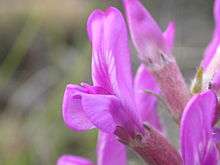Oxytropis lambertii
| Oxytropis lambertii | |
|---|---|
 | |
| Scientific classification | |
| Kingdom: | Plantae |
| (unranked): | Angiosperms |
| (unranked): | Eudicots |
| (unranked): | Rosids |
| Order: | Fabales |
| Family: | Fabaceae |
| Subfamily: | Faboideae |
| Tribe: | Galegeae |
| Genus: | Oxytropis |
| Species: | O. lambertii |
| Binomial name | |
| Oxytropis lambertii Pursh | |
Oxytropis lambertii is a species of flowering plant in the legume family known by several common names, including purple locoweed, woolly locoweed, and Lambert crazyweed.
Distribution
It is native to grasslands in the Canadian Prairie of central Canada and in the mid-west and Great Plains of the United States.[1]
Description
Oxytropis lambertii is a perennial herb producing a patch of basal leaves around the root crown, and several showy erect inflorescences. The leaf is compound with several silvery-green leaflets. The inflorescence produces several flowers, each borne in a tubular purple or pinkish calyx of sepals covered thinly in silver hairs. The pealike flower corolla is reddish or bluish purple with a lighter patch at the base of the banner. The fruit is a cylindrical legume pod.
Toxic
The Oxytropis lambertii plant is one of the locoweeds most frequently implicated in livestock poisoning.[2] The toxin is called swainsonine. Research suggests that the plant itself may not be toxic, but becomes toxic when inhabited by endophytic fungi of the genus Embellisia, which produce swainsonine.[3]
References
- ↑ USGS. Native Wildflowers of the North Dakota Grasslands
- ↑ Ralphs, M. H., et al. (2002). Distribution of locoweed toxin swainsonine in populations of Oxytropis lambertii. J Chem Ecol 28:4 701-7.
- ↑ McLain-Romero, J., et al. (2004). The toxicosis of Embellisia fungi from locoweed (Oxytropis lambertii) is similar to locoweed toxicosis in rats. J Anim Sci 82 2169-74.
See also
External links
| Wikimedia Commons has media related to Oxytropis lambertii. |